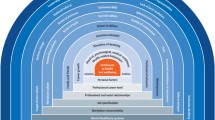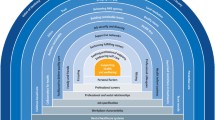Key Points
-
Describes the development and absorption of the chemist–dentist into dental practice.
-
Illustrates the chemist–dentists as co-heirs of the toothdrawers
-
Shows social change in dentists' identity
-
Accounts for the ending of dental apprenticeships
-
Notes the change in educational patterns in dentistry in the nineteenth century
Abstract
The Apothecaries Act of 1815,1 (revised by the Act of 1823)2, has been credited with being the most important forward step in the education of the general medical profession in the nineteenth century,3 although a closely argued revisionist view of its significance by S W F Holloway4 makes clear his view that it was also a successful and deeply reactionary political move by the Physicians to emasculate a rival group growing rapidly in numbers and power. The first part of this paper5 showed how the apothecary/general medical practitioner was removed from competition with the emerging dental practitioner. This second paper illustrates the quite astonishing reversal of fortune between chemists who practised dentistry, and the pure dentists, following the Act. It also points to the influence of the Act on the social position, education, and qualification of dentists.
Similar content being viewed by others
Log in or create a free account to read this content
Gain free access to this article, as well as selected content from this journal and more on nature.com
or
References
An Act for the better regulating the Practice of Apothecaries throughout England and Wales. 55 Georgii III C.194. 12th July 1815.
An Act to amend and explain an Act of the fifty fifth year of His late Majesty, for better regulating the Practice of Apothecaries through England and Wales. 6 Georgii IV C.133. 6th July 1825.
eg Cope Sir Z 'Influence of the Society of Apothecaries on Medical Education'. Br Med J 1956; 1: 1–6.
Holloway SW F The Apothecaries Act, 1815; A Reinterpretation. Med Hist 1966; 10: 107–129 221–236.
Bishop MGH, Gelbier S Ethics: How the apothecaries act of 1815 shaped the dental profession. Part 1. The apothecaries and the emergence of the profession of dentistry. Br Dent J 2002; 193: 627–631.
Table Showing the Number and Qualifications, with Percentage of the total, of Persons registered in the Dentists Register up to August 1, 1879 London: The General Medical Council 1870 p24.
Indenture LDBDA 06.9 in the BDA Archive.
Hillam CF The development of Dental Practice in the Provinces from the late 18th century to 1855 PhD Thesis 1986. Liverpool: University of Liverpool.
Hillam C Brass Plate and Brazen Impudence Liverpool: Liverpool University Press 1991 p19.
Parliamentary Debates – House of Commons Dentists Bill – Committee Tuesday June 7. Br Dent J 1921; 42: 575.
Dentists Act 1848 42&42 Vict. Ch33.
Select Committee on Medical Education 1834 (602-III) Part III. Appendix 7, p101 (Source: Holloway op. cit. p235).
Davies J An Exposition of the Laws which relate to the Medical Profession in England. 1844 p64 (Source: Holloway op. cit. p224).
Bishop M, Gibbons D, Gelbier S Ethics: In Consideration of the Love he Bears. Apprenticeship in the nineteenth century and the development of professional ethics in dentistry. Br Dent J 2002; 193: 261.
Reports from the Select Committee on Public Petitions, 1833 Appendix 296 p251 (Source: Holloway op. cit.
The Companion to the Newspaper August 1833 pp119–120 (Source: Holloway 1966 op. cit. p223).
Holloway SWF Medical education in England 1830-1858: A Sociological Analysis. Hist 1964; 49: 299–324.
Commentary and quotation from Holloway 1966 op.cit. p233. Quotation from The Quarterly Review December 1840; 67 p65.
Report by a Royal Commission of Enquiry into the State of the Universities of Scotland. 1831; (310) XII p67 (Source: Holloway 1966 op. cit. p224).
Reports from the Select Committee on Public Petitions. 1833; Appendix 296 p251 (Source: Holloway op. cit. p224).
Report from the Select Committee on Public Petitions. 1833; Appendix 737 p827 (Source: Holloway 1966 op. cit. p225).
Select Committee on Medical Education 1834. (602-II) XIII, Part II, Q.4944, p48 (source Holloway 1966 op. cit. p225).
Holloway 1966 op. cit. p227.
Hill A The History of the Reform Movement in the Dental Profession in Great Britain. London: Trubner & Co 1877.
Lindsay L Personalities of the Past. London. Br Dent J 1955; 98: 295–296.
Hillam C Brass Plate and Brazen Impudence. Liverpool: Liverpool University Press 1991 Ch2.
Lindsay L Personalities of the Past. London. Br Dent J 1955; 99: 164.
23rd Victoria 8th September 1859.
Woodforde J The Strange Story of False Teeth. London: Routledge & Keegan Paul 1968 p36.
Hill A The History of the Reform Movement in the Dental Profession in Great Britain. London. London: Trubner & Co 1877 p21.
ibid p22.
Hillam C Brass Plate and Brazen Impudence. Liverpool: Liverpool University Press 1991: Ch5.
Observations on the Present System of Medical Education with a view to Medical Reform. 1834 p10 (Source: Holloway 1966, op.cit. p227).
Acknowledgements
The paper by S W F Holloway is strongly recommended as further reading, and acknowledgement is here given to it as a source in depth for the medical background for this paper. Also Christine Hillam's account is much to be recommended. Mr Christopher Liddle, late of the College of Law, assisted with advice and the location of legal documents essential to the paper.
Author information
Authors and Affiliations
Corresponding author
Additional information
Refereed paper
Rights and permissions
About this article
Cite this article
Bishop, M., Gelbier, S. Ethics: How the Apothecaries Act of 1815 shaped the dental profession. Part 2. The chemist–dentists and the education of dentists. Br Dent J 193, 683–686 (2002). https://doi.org/10.1038/sj.bdj.4801660
Received:
Accepted:
Published:
Issue date:
DOI: https://doi.org/10.1038/sj.bdj.4801660
This article is cited by
-
J. M. W. Turner's painting The unpaid bill, or the dentist reproving his son's prodigality
British Dental Journal (2004)



